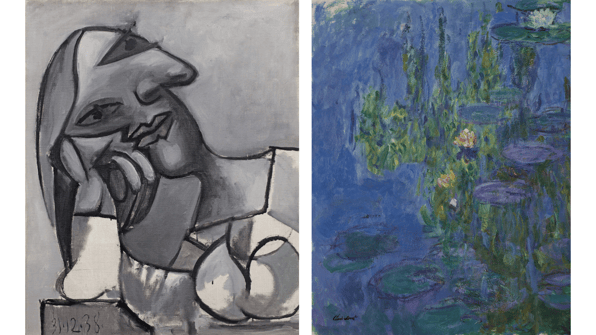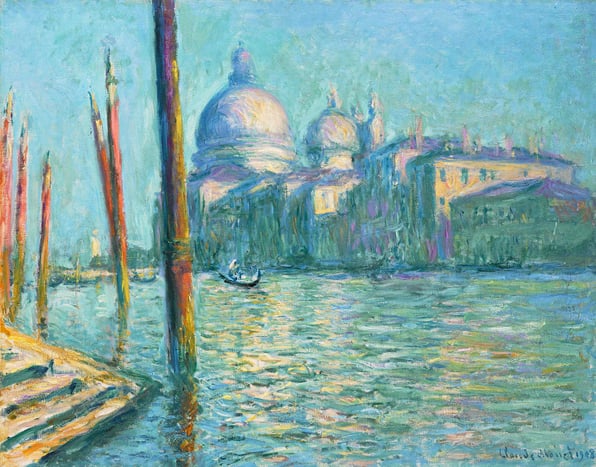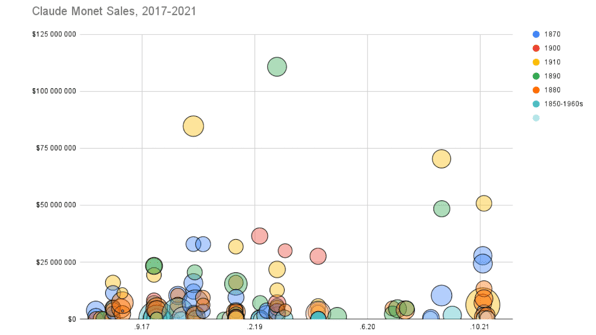A Suite of Five Monets Estimated at $40 million Anchor Sotheby’s March Sale in London
An American collector is selling five works by the porto-abstractionist master now much in demand by Asian collectors
Five works by Claude Monet are coming to Sotheby’s for their Modern and Contemporary Evening auction in London March 2nd. With the dad-joke title of Monet x Monet | A Distinguished American Collection, the works have a combined estimate around $40 million (£30m).
The five works are Massif de chrysanthèmes, estimated at £10 million; Les Demoiselles de Giverny also estimated at £10 million; Glaçons, environs de Bennecourt, estimated at £5 million; Sur la falaise près de Dieppe, soleil couchant, estimated at £3.5 million; and a still life Prunes et Abricots, estimated at £1.2 million.
“With Picasso and Van Gogh, Monet is one of the most sought-after artists in the world today,” observes Helena Newman, Chairman of Sotheby's Europe and Worldwide Head of Impressionist & Modern Art. “In recent years the energy around him has taken on an even more renewed vigor, both in the global exhibition arena and among collectors all around the world – particularly in Asia where he is a beloved figure.”
“Monet was a key influence on the abstract movements of the 20th century,” says Simon Shaw, Sotheby’s Vice Chairman, Fine Arts. “Long after his death in 1926, he remains a strong and relevant force. Tellingly, in the 1950s, with the rise of Abstract Expressionism, The Museum of Modern Art acquired a water lily for their collection – this symbiotic relationship has continued to be explored in the years that followed, with the Musée Marmottan’s ground-breaking ‘Monet & Abstraction’ exhibition in 2010, and currently in the Helen Frankenthaler exhibition at the Dulwich Picture Gallery in London.”
Massif de chrysanthèmes, estimated at £10 – 15 million, is one of four still-lifes devoted to chrysanthemums painted by Monet in 1897. In 1854, Japanese ports opened up to Western trade for the first time in 200 years, sparking a vogue for Japonisme that penetrated almost every aspect of Western life. Monet first came across Japanese prints at this time. He quickly became a keen collector, adorning the walls of his studio with prints which were a complement to flowers (including chrysanthemums) he grew in his garden.
The Chrysanthemum holds a special status in Japan – a symbol of power and, often, of the country itself. This picture was most recently exhibited in Japan in 1995, and at one time during its prestigious ownership history, it entered a private Japanese collection.
 Claude Monet, Massif de chrysanthèmes (estimate £10 million)
Claude Monet, Massif de chrysanthèmes (estimate £10 million)Les Demoiselles de Giverny, estimated at £15 – 20 million, features a collection of meulettes. Revisiting the subject in 1894, following the celebrated series of Haystacks he painted in 1890-91, the painting’s title, “The Young Ladies of Giverny”, takes its name from the colloquial French expression and evokes moving figures within a landscape, echoing the many occasions he had painted female figures set within the natural world in the 1870s.
 Monet, Les Demoiselles de Giverny, (estimate £15 million)
Monet, Les Demoiselles de Giverny, (estimate £15 million)Glaçons, environs de Bennecourt, estimated at £5 – 7 million, also shows Monet’s progression towards his water lily paintings of the 20th century. During late December 1892 and January 1893, the length of the Seine experienced severe frost and heavy snow. Capturing the ice floes on the river’s surface was a nascent flowering of the water lily paintings, which Monet would begin just a few years later.
Sur la falaise près de Dieppe, soleil couchant, estimated at £3.5 – 5 million, was painted in 1897, is from a series of works depicting the Normandy coast. The paintings were unusual in their choice of colors, as Monet uses a soft Mediterranean palette to paint the dramatic northern perimeter of France. Reducing nature’s forms to their essence with gestural brushwork represented Monet’s first forays into abstraction.
Completing the group is Prunes et Abricots, painted circa 1882-85 during a period when Monet’s output started to reach a wider audience and gain increasing recognition. Art dealer Paul Durand-Ruel had commissioned a series of decorative panels depicting flowers and fruit for the grand salon in his Paris apartment. While Prunes et abricots was not part of the final design, this still life, estimated at £1.2 – 1.8 million, was acquired by the dealer in 1890.





